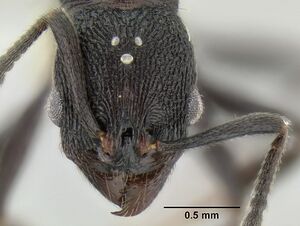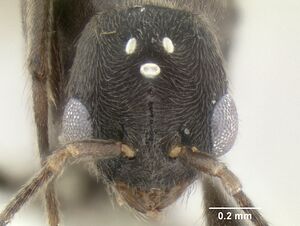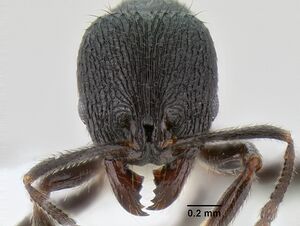Stenamma felixi
| Stenamma felixi | |
|---|---|

| |
| Scientific classification | |
| Kingdom: | Animalia |
| Phylum: | Arthropoda |
| Class: | Insecta |
| Order: | Hymenoptera |
| Family: | Formicidae |
| Subfamily: | Myrmicinae |
| Tribe: | Stenammini |
| Genus: | Stenamma |
| Species: | S. felixi |
| Binomial name | |
| Stenamma felixi Mann, 1922 | |
Stenamma felixi is one of the most widespread and common species of Middle American Stenamma. It occurs from approximately 50–1600 m, but is most common above 500 m, and is always found in wet forest environments, ranging from lowland rainforest to cloud forest. Workers have been collected by sifting leaf litter, beating and sweeping vegetation, baiting, using pitfall and Malaise traps, and by general searching. Nests are generally quite large and have been found in rotting logs on the ground, in tree stumps, under bark of logs, and rarely in mud banks. A few lone foundresses have been found under rotting epiphyte clumps in old treefalls, and some workers have been collected from orchids at quarantine in the U.S. All colonies collected so far have been monogynous. Workers seem to be epigeic, solitary foragers, but nothing is known about dietary preference. A very common experience is to find lone, stray workers running across medium- to large-sized logs in forest.
Identification
Branstetter (2013) - Integument mostly black to dark brown; medium- to large-sized species (see HL, ML, PrW below); anterior clypeal margin with a median emargination; basal margin of mandible straight to slightly sinuous, without a basal notch or depression; head and mesosoma usually densely sculptured, with sharp carinae, rugae, or rugoreticulae; eye relatively large (EL 0.16–0.20, REL 18–22), oval-shaped, with 8–11 ommatidia at greatest diameter; propodeal spines absent, propodeum forming shallow, blunt angles where propodeal dorsum and declivity converge (PSL 0.07–0.11, PSI 0.8–1.1); setae on gastral tergites mostly sparse, long, and suberect, only sometimes with a few short decumbent setae; frontal lobes of moderate width (FLD 0.22–0.26, FLI 25–29), not completely obscuring torular lobes in full face view; metafemur relatively long (MFI 75–88). Similar species: Stenamma manni, Stenamma schmidti.
Over its range, S. felixi shows considerable variation in the density and orientation of its sculpturing as well as in petiole shape. Specimens from Nicaragua and Costa Rica have very deep carinate sculpturing on the face and mesosoma. The facial carinae are usually longitudinal, but occasionally reticulate laterad. The pronotal dorsum has longitudinal carinae, but the side of the pronotum has arcuate carinae that wrap across the dorsum of the metanotum. The head in profile view has a very distinctive shape, in which the posterior margin of the head is very wide compared to the anterior margin, giving the head a somewhat triangular appearance. Lastly, the petiolar and postpetiolar nodes are noticeably smooth. Specimens from Colombia and Ecuador and from north of Nicaragua lose the carinate sculpture. All of the slight sculpture differences among popluations are treated as intraspecific variation as there is no evidence of sympatry among forms.
This species is rather distinctive with its large size, lack of propodeal spines, and dense sculpturing. It should not be easily confused with any other Middle American clade species.
Keys including this Species
Distribution
Atlantic Slope of Mexico to Ecuador.
Latitudinal Distribution Pattern
Latitudinal Range: 21.155° to -2.4405°.
| North Temperate |
North Subtropical |
Tropical | South Subtropical |
South Temperate |
- Source: AntMaps
Distribution based on Regional Taxon Lists
Neotropical Region: Belize, Colombia, Costa Rica, Ecuador, Guatemala, Honduras (type locality), Mexico, Nicaragua, Panama.
Distribution based on AntMaps
Distribution based on AntWeb specimens
Check data from AntWeb
Countries Occupied
| Number of countries occupied by this species based on AntWiki Regional Taxon Lists. In general, fewer countries occupied indicates a narrower range, while more countries indicates a more widespread species. |

|
Estimated Abundance
| Relative abundance based on number of AntMaps records per species (this species within the purple bar). Fewer records (to the left) indicates a less abundant/encountered species while more records (to the right) indicates more abundant/encountered species. |

|
Biology
Castes
Images from AntWeb
 
| |
| Lectotype (bottom specimen) Stenamma felixi. Worker. Specimen code casent0126355. Photographer Michael Branstetter, uploaded by Default Group. | Owned by USNM. |
        
| |
| Worker. Specimen code casent0620969. Photographer Michael Branstetter, uploaded by Curator Michael Branstetter. | Owned by MGBPC. |
    
| |
| Queen (alate/dealate). Specimen code casent0622308. Photographer Michael Branstetter, uploaded by Default Group. | Owned by MGBPC. |
   
| |
| Male (alate). Specimen code casent0622311. Photographer Michael Branstetter, uploaded by Default Group. | Owned by MGBPC. |
    
| |
| Worker. Specimen code casent0622555. Photographer Michael Branstetter, uploaded by Default Group. | Owned by MGBPC. |
Males have been collected but have not been described.
Nomenclature
The following information is derived from Barry Bolton's Online Catalogue of the Ants of the World.
- felixi. Stenamma felixi Mann, 1922: 21, fig. 10 (w.) HONDURAS, MEXICO (Veracruz).
- Type-material: lectotype worker (by designation of Branstetter, 2013: 114), 5 paralectotype workers.
- [Note: originally described from 6 syntype workers.]
- Type-locality: lectotype Honduras: San Juan Pueblo, ii-iii.1920 (W.M. Mann); paralectotypes with same data.
- Type-depositories: USNM (lectotype); MCZC, USNM (paralectotypes).
- Branstetter, 2013: 116 (q.m.).
- Status as species: Smith, M.R. 1962a: 34; Kempf, 1972a: 242; Bolton, 1995b: 393; Branstetter & Sáenz, 2012: 261; Branstetter, 2013: 114 (redescription); Fernández & Serna, 2019: 800.
- Distribution: Belize, Colombia, Costa Rica, Ecuador, Guatemala, Honduras, Mexico, Nicaragua, Panama.
Unless otherwise noted the text for the remainder of this section is reported from the publication that includes the original description.
Description
Worker
Branstetter (2013) - (10 measured) HL 0.90–1.19 (1.00), HW 0.81–1.04 (0.87), FLD 0.22–0.26 (0.22), PCW 0.04–0.09 (0.05), SL 0.69–0.95 (0.81), EL 0.16–0.20 (0.17), ACL 0.70–0.92 (0.79), ML 1.25–1.62 (1.37), PrW 0.58–0.74 (0.62), PSL 0.07–0.11 (0.09), SDL 0.07–0.13 (0.08), PL 0.41–0.52 (0.45), PH 0.25–0.32 (0.29), PW 0.16–0.23 (0.23), PPL 0.24–0.33 (0.28), PPH 0.21–0.27 (0.23), PPW 0.18–0.27 (0.18), MFL 0.93–1.28 (1.08), MTL 0.71–0.98 (0.81), CI 83–90 (87), SI 84–101 (93), REL 18–22 (20), FLI 25–29 (26), PSI 0.8–1.1 (1.1), MFI 75–88 (81), ACI1 57–62 (59), ACI2 93–102 (97).
Medium- to large-sized species; general body color mostly black to dark brown, with appendages lighter, brown to orange-brown toward extremities; setae dark gold-brown; mandible with 5–6 teeth, consisting of 4 distinct apical teeth, a basal tooth, and 1 tooth in between, which is smaller and often effaced; basal margin of mandible straight to slightly sinuous, without a basal notch or depression; mandible mostly smooth, except for scattered piligerous punctae, and some lateral striations; anterior clypeal margin with a shallow median emargination; median lobe of clypeus with at least a pair of distinct longitudinal carinulae that diverge toward anterior margin, sometimes with a few additional faint carinulae, apex of lobe smooth, or with some faint transverse carinulae; remainder of clypeus mostly smooth and shiny; posterior extension of clypeus between frontal lobes of moderate width (PCW 0.04–0.09), sides subparallel to slightly hour-glass-shaped; frontal lobes of moderate width (FLD 0.22–0.26, FLI 25–29), not greatly obscuring torular lobes in full face view; head usually roughly oval-shaped, but some populations with posterior margin distinctly broader than anterior margin, making head appear more triangular (CI 83–90), posterior margin always depressed medially; eye relatively large (EL 0.16–0.20, REL 18–22), oval-shaped, with 8–11 ommatidia at greatest diameter; face densely sculptured, but sculpture type variable, most often with some longitudinal rugae/carinae along midline, transitioning to rugoreticulae toward lateral margins, but sometimes face almost completely rugoreticulate, or completely carinate, depth and sharpness of sculpture variable; scape of moderate length (SI 84–101), just reaching posterior margin of head when laid back; scape surface mostly smooth, but with distinct carinulae, and scattered piligerous punctures; scape sometimes appearing thickened and more robust; flagellum with distinct 4-segmented antennal club; mesosoma mostly densely sculptured, but sculpture type variable; dorsum of pronotum usually rugose (longitudinal orientation) to rugoreticulate, but sometimes carinate, anterior declivity of pronotum with transverse carinulae; dorsum of mesonotum rugoreticulate to transversely carinate, sometimes intermediate; side of pronotum rugulose to carinate; katepisternum mostly smooth, with some rugulae on upper half; dorsum and declivity of propodeum transversely carinate/carinulate; side of propodeum rugose; promesonotum in profile domed (higher than average), symmetrical to slightly asymmetrical, with location of apex variable; metanotal groove distinct, but narrow; dorsum of propodeum in profile distinctly longer than declivity; propodeal spines absent, propodeum forming shallow, blunt angles where dorsum and declivity converge (PSL 0.07–0.11, PSI 0.8–1.1); petiole of moderate length (PL/HW 0.48–0.55); petiolar node of moderate height (PH/PL 0.60–0.64), subconical in shape, usually pointing vertically to only slightly posteriad, dorsum narrowly to somewhat broadly rounded, posterior margin of petiole, where postpetiole inserts, distinctly bent downwards; postpetiole in profile nearly symmetrical, with anterior face slightly longer than posterior face, postpetiole similar in size to petiolar node (PPH/PH 0.78–0.85); petiole and postpetiole usually mostly punctate, with only anterior faces of nodes smooth, but sometimes nodes mostly smooth, with punctae faint; gaster smooth, with scattered piligerous punctae; most of body dorsum with standing pilosity; setae on gastral tergites mostly sparse, long, and suberect, only sometimes with a few short decumbent setae; setae on scapes subdecumbent to appressed; setae on legs decumbent to appressed, with a few suberect setae on femoral venters and coxae.
Queen
(6 measured) HL 1.00–1.17 (1.07), HW 0.85–0.98 (0.89), FLD 0.25–0.27 (0.25), PCW 0.05–0.08 (0.07), SL 0.76–0.92 (0.84), EL 0.23–0.30 (0.29), ACL 0.69–0.91 (0.83), ML 1.45–1.75 (1.57), PrW 0.79–0.91 (0.83), PSL 0.11–0.15 (0.13), SDL 0.12–0.16 (0.14), PL 0.51–0.59 (0.55), PH 0.31–0.36 (0.33), PW 0.21–0.25 (0.23), PPL 0.30–0.37 (0.35), PPH 0.26–0.31 (0.29), PPW 0.26– 0.32 (0.31), MFL 0.96–1.27 (1.11), MTL 0.74–0.95 (0.85), CI 83–88 (83), SI 87–97 (94), REL 27–32 (32), FLI 27–30 (28), PSI 0.9–1.0 (0.9), MFI 76–88 (81), ACI1 58–61 (59), ACI2 90–99 (99).
Same as worker except for standard queen modifications and as follows: pronotum transversely carinulate; mesoscutum longitudinally carinulate, or carinate; scutellum rugoreticulate, or longitudinally carinulate to carinate; propodeum with transverse carinulae/carinae that wrap around surface; mesopleuron usually mostly smooth; pi- losity on gastral tergites clearly bilayered, with a sparse layer of long, suberect setae, and a dense layer of appressed pubescence; wing venation in specimen CASENT0622308.
Type Material
- Lectotype (designated by Branstetter, 2013: 114), worker, San Juan Pueblo, Atlántida, Honduras, 15°34′59″N 87°13′59″W / 15.583°N 87.233°W, February-March, 1920, W.M. Mann, USNM, Cotype. No. 24448, pin CASENT0126355, bottom specimen, National Museum of Natural History.
References
- Branstetter, M. G. 2012. Origin and diversification of the cryptic ant genus Stenamma Westwood (Hymenoptera: Formicidae), inferred from multilocus molecular data, biogeography and natural history. Systematic Entomology 37:478-496. doi:10.1111/j.1365-3113.2012.00624.x.
- Branstetter, M.G. 2013. Revision of the Middle American clade of the ant genus Stenamma Westwood (Hymenoptera, Formicidae, Myrmicinae). ZooKeys 295, 1–277. doi:10.3897/zookeys.295.4905
- Mann, W. M. 1922. Ants from Honduras and Guatemala. Proc. U. S. Natl. Mus. 61: 1-54 (page 21, fig. 10 worker described)
References based on Global Ant Biodiversity Informatics
- Branstetter M.G. 2013. Revision of the Middle American clade of the ant genus Stenamma Westwood (Hymenoptera, Formicidae, Myrmicinae). ZooKeys 295: 1277
- Dattilo W. et al. 2019. MEXICO ANTS: incidence and abundance along the Nearctic-Neotropical interface. Ecology https://doi.org/10.1002/ecy.2944
- Del Toro, I., M. Vázquez, W.P. Mackay, P. Rojas and R. Zapata-Mata. Hormigas (Hymenoptera: Formicidae) de Tabasco: explorando la diversidad de la mirmecofauna en las selvas tropicales de baja altitud. Dugesiana 16(1):1-14.
- Fernandes, P.R. XXXX. Los hormigas del suelo en Mexico: Diversidad, distribucion e importancia (Hymenoptera: Formicidae).
- Fernández, F. and S. Sendoya. 2004. Lista de las hormigas neotropicales. Biota Colombiana Volume 5, Number 1.
- INBio Collection (via Gbif)
- Kempf, W.W. 1972. Catalago abreviado das formigas da regiao Neotropical (Hym. Formicidae) Studia Entomologica 15(1-4).
- Longino J. T. 2013. Ants of Nicargua. Consulted on 18 Jan 2013. https://sites.google.com/site/longinollama/reports/ants-of-nicaragua
- Longino J. T. L., and M. G. Branstetter. 2018. The truncated bell: an enigmatic but pervasive elevational diversity pattern in Middle American ants. Ecography 41: 1-12.
- Longino J. T., J. Coddington, and R. K. Colwell. 2002. The ant fauna of a tropical rain forest: estimating species richness three different ways. Ecology 83: 689-702.
- Longino J. T., and R. K. Colwell. 2011. Density compensation, species composition, and richness of ants on a neotropical elevational gradient. Ecosphere 2(3): 16pp.
- Longino J. et al. ADMAC project. Accessed on March 24th 2017 at https://sites.google.com/site/admacsite/
- Maes, J.-M. and W.P. MacKay. 1993. Catalogo de las hormigas (Hymenoptera: Formicidae) de Nicaragua. Revista Nicaraguense de Entomologia 23.
- Patrick M., D. Fowler, R. R. Dunn, and N. J. Sanders. 2012. Effects of Treefall Gap Disturbances on Ant Assemblages in a Tropical Montane Cloud Forest. Biotropica 44(4): 472478.
- Smith M. R. 1962. A remarkable new Stenamma from Costa Rica, with pertinent facts on other Mexican and Central American species (Hymenoptera: Formicidae). Journal of the New York Entomological Society 70: 33-38.
- Vásquez-Bolaños M. 2011. Lista de especies de hormigas (Hymenoptera: Formicidae) para México. Dugesiana 18: 95-133

